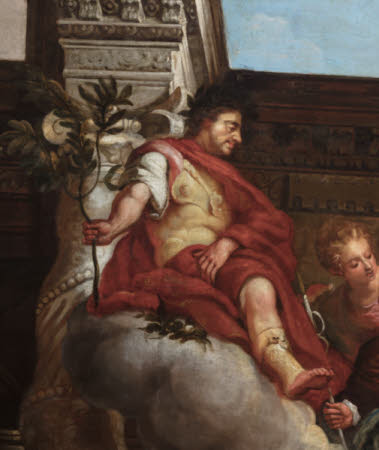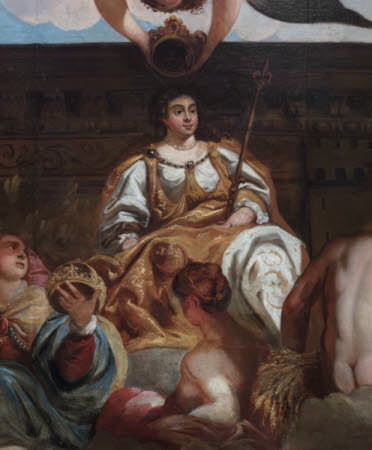The Crowning of Queen Catherine of Braganza
attributed to Gerard Lanscroon (Mechelen 1655 - Soho, London 1737)
Category
Art / Wall paintings
Date
1674 - 1685
Materials
Oil on canvas
Place of origin
Great Britain
Order this imageCollection
Powis Castle and Garden, Powys
NT 1181277
Summary
Oil painting on canvas laid into ceiling, The Crowning of Queen Catherine of Braganza (1638-1705), attributed to Gerard Lanscroon (Mechelen or Malines, fl. in England from 1655 - Soho, London 1737), 1674/85. Painted before the death of Charles II on 6th February 1685. Adapted from Paolo Veronese's Apotheosis of Venice 1553-55 in the Sala del Maggior Consiglio in the Doge's Palace, Venice (probably after the engraving by Valentin Lefebvre (Brussels c.1641 – Brussels c.1680). The impaled arms of Herbert and Somerset, still under what is only an earl's coronet (so likewise date it before 1685) have been placed under the male nude with a dog at the bottom, flanked by feigned recumbent statues of Victory and Fame. Catherine and King Charles II (holding an olive-branch, to the left of her) have both been given portrait features. Jupiter and a heavenly host have been added to the top of the painting, to fill the ellipse out into a rectangle. The clouds at the top of the painting is populated with mythological figures representing Greek or Roman gods with Jupiter (Zeus) in the centre holding a thunderbolt. In the center of the painting, being crowned, is a female figure in a white and gold gown holding a sceptre. The figure is believed to be the Catholic Queen Catherine of Braganza, wife of Charles II. She is seated on a cloud and surrounded by mythological figures. To her right is a bearded man in roman armour and wearing a laurel wreath who may represent Charles II. Below is a balustrade populated with figures in 17th-century dress and bearing a double 'c' cypher surmounted with a crown similar to that in the State bedroom. Below the balustrading are three soldiers on horseback and more figures. The bottom of the painting is decorated in the grisaille style displaying the heraldic shield of William Herbert, 1st Earl of Powis between two reclining figures.
Provenance
Commissioned by William Herbert, 1st Earl and 1st Marquis of Powis (1626-1696); part of the indigenous collection of Powis Castle which Edward Henry Herbert, 5th Earl of Powis agreed with the Commissioners of the Inland Revenue to be accepted in part satisfaction to the extent of £158,400 of the Estate duty for which he was accountable in connection with the death of the Right Honourable George Charles, 4th Earl of Powis, on 9th November 1952.
Makers and roles
attributed to Gerard Lanscroon (Mechelen 1655 - Soho, London 1737), artist previously catalogued as attributed to Antonio Verrio (Lecce c.1639 – Hampton Court Palace 1707), artist after Valentin Lefebvre (c.1641 – c.1680), engraver (printmaker) after Paolo Veronese (Verona 1528 -Venice 1588), artist
References
Croft-Murray 1962-1970: Edward Croft-Murray, Decorative Painting in England, 1537 - 1837 (2 vols), 1962-1970, vol.I, p.239 & p. 255


